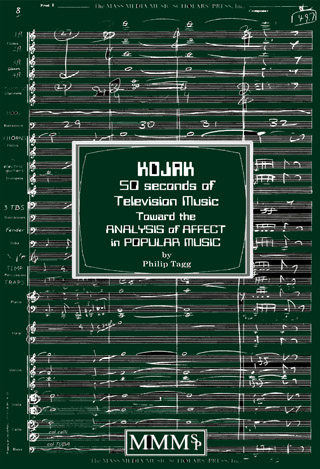Philip
Tagg: Kojak: 50 Seconds of Television Music
(Towards the Analysis of Affect in Popular Music)
——
• 424 pp. • 187 music examples •
92 figures and tables.
e-book ISBN
978-0-9701684-9-8
First published 1979 as PhD from
Göteborg University Musicology Depatrment
(Skrifter från musikvetenskapliga institutionen, no. 2)
THE MASS MEDIA MUSIC SCHOLARS' PRESS,
INC.
2000 MMMSP,
Updated 11 Jan 2016, 11 Nov 2021
————
'A classic of popular music semiotics',
‘refreshing’, ‘heroic’, ‘‘useful and practical’,
‘ a major paradigm shift’, ‘original’, more opinions
———
 |
|
Description
By 1976 the title theme for the TV series Kojak had been heard by at least 100 million people in at least seventy countries. It is an infinitesimal part of all the mass media music outside the traditional musicological frames of reference. Tagg argues that conventional musicology cannot help us understand how music works on an everyday basis in the popular mass media market of ideas. This book not only reveals, in fascinating detail, how a widely disseminated piece of music can influence the TV-viewer’s evaluation of people and places: it also presents a solid methodological basis for analysing music as if it actually meant something.
• Table of contents
• from chapter 6
• from chapter 7
Extras
— Page
number conversion table (1979 <–> 2000 editions.)
— Score
— Errata
Opinions about 'Kojak - 50 Seconds of Television Music'
“Tagg’s
procedure is an imaginative synthesis of work in many fields and opens
the way to an extraordinarily broad and inviting research domain… The
most pregnant assertions in this work, which involve the reaffirmation
and formalisation of a hermeneutical approach to music, are fully convincing.
Their fertility is attested by the richness of the analytical example
provided.”
(Bill Brooks in Svensk tidskrift för musikforskning)
“refreshing”, “heroic scholarship” (Mark Steedman in Popular Music)
“Such detailed
discussion of 50 seconds of everyday TV music may seem excessive, but
the stimulating approach and results of Tagg’s work make for really worthwhile
reading and suggest the opposite.”
(Andreas Ballstaedt in Musikforschung)
‘Tagg’s
books are the only academic works, on music in media, that dare pull off
the muse’s mask. In this they provide a useful and practical way
of thinking that can help those of us involved in the industrial process
that Hollywood music is today.’
(Peter D Kaye, music editor and composer, Santa Monica).
“If Tagg
were in a context in which music semiotics existed as a matter of course,
he could simply refer. But, unfortunately, most of his steps are absolutely
necessary – he has to rebuild the whole of Western musical semiotics before
he can unpack the theme from Kojak.”
(Susan McClary and Rob Walser in On Record)
“a major paradigm shift in musicology” (Jan Ling)
“Official
musicology seems to know no better than to concern itself with the music
of a highly selective and particular part of society. In this sense Tagg
is like the one-eyed man in the land of the blind because his approaches
are new. They should have been developed and tested decades ago.”
(Leo Sanama in Haagse Post)
“richly suggestive”...
“Tagg’s approach works well”
(Richard Middleton in Studying Popular Music)
“An extraordinary
book on an extraordinary topic… uniquely original, comprehensive and pioneering…
Musicologists interested in the secrets of musical mass influence must
read this book. I am sure that anybody concerned with complex analysis,
semiology, and especially with multi-channel processes of contemporary
audiovisual media can find here abundant sources of inspiration.”
(János Maróthy in Studia Musicologica Academiae Scientiarum
Hungaricae)